Car Wash Mag Article
Detailers, go for the gold
Most business owners would like to have the opportunity to increase their net profits by offering more services for their customers. The challenge is finding a way to increase revenues that doesn’t involve risky capital expenditures or increasing overall costs beyond the added revenue. Many automotive service businesses have found that although it’s not an effortless problem-free panacea, gold plating can be a valuable addition to their business.
There are several reasons that automotive gold plating is a popular offering for businesses already providing automotive stylizing, care or maintenance services. Some of these are;
- High profit margin - cost of good and labor normally 15%- 20%
- Low capital investment – usually less than $3000
- Low operating overhead – does not require dedicated floor space or personnel
- Low liability risk – the worst mistakes would usually only result in having to replace an emblem
It was in the early 1990’s that the automotive gold rush began in earnest. The boom was enabled by the creative talents of a few enterprising individuals. These entrepreneurs refined existing brush plating technology that had formerly been limited to specialized areas of the electronics industry. In the last dozen years, the resulting equipment and procedures have evolved into a wide range of “on-site” automotive gold plating systems.
Because of its unique nature, the business of providing automotive gold plating has been marketed primarily as a dealership aftermarket product. The gold plating is usually performed by independent businesses or automotive aftermarket specialty shops. Dealerships routinely charge $500 or more for an optional 5-emblem gold package which worked for the customer since the price was built into the monthly payment. The dealership normally used an independent contractor or detail shop and paid a wholesale price in the $150 range. About half the time the gold package isn’t put on the car until after the deal is struck with the customer. This flexibility along with the high margin on the gold package gives the sales personnel a fairly low cost, high value “buy-now closer”
With the equipment, training and technical support available from current vendors, the plating process is simple to master. This simplicity has allowed other types of automotive service businesses such as quick lube, tire stores and full service car washes to offer automotive gold plating as a side profit center. Some of these businesses have their own plating system and use their employees to perform the plating. Others, choose to enter into agreements with on-site plating specialists that come on the premises and provide the service and share the revenue with the business owner.
While there are a couple of versions of automotive gold plating, the most widely accepted process of gold plating chrome emblems without removing them from the vehicle involves three general steps.
1. Remove the existing chrome from the surface to be gold plated.
2. Activate the underlying nickel surface.
3. Plate with 24K gold.
In today’s online marketplace there are several automotive gold plating systems offered by a range of vendors. I would suggest that anyone considering adding automotive gold plating to their business take the time to do adequate research to be certain that you deal with a reputable, well established business.
While there may be different approaches to performing the three basic steps, there are several functions that should be considered when providing any on-site gold plating;
Rinse Water Collection And Disposal
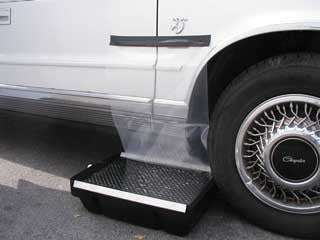 After each step of the preparation and gold plating process, the emblem being plated and the common clip are rinsed with a spray rinse bottle using tap water. It is important to have an efficient method of setting up rinse water collection. The first line of contact is generally a high quality vinyl tape that can be re-used many times and will not leave residual adhesive on the paint. The drain apron deposits the rinse water into a “drain pan”. The drain pan is a collection and holding reservoir for the rinse water. An “apron bar" or stainless steel grounding tray (as shown here) holds the apron tight. Keeping the apron tight and flat prevents the rinse solution from dripping off the drain apron before it gets to the drain pan. The drain pan has 2 re-sealable plugs in the top to allow the liquid to drain inside and a spout on the end so the solution can be poured into a suitable storage container. When not in use, the drain pan can be totally sealed for storage. The rinse water contains substances that are considered hazardous and should not be discharged into the sanitary sewer. When properly performed, the brush plating process produces a minimal amount of waste water that can easily be disposed of utilizing the services of one of the many hazardous waste disposal companies. The disposal company may or may not have a one time “profiling” charge to determine the hazardous components of your rinse water. We have found the cost of rinse water disposal is generally around between 8% and 10% of wholesale revenue.
After each step of the preparation and gold plating process, the emblem being plated and the common clip are rinsed with a spray rinse bottle using tap water. It is important to have an efficient method of setting up rinse water collection. The first line of contact is generally a high quality vinyl tape that can be re-used many times and will not leave residual adhesive on the paint. The drain apron deposits the rinse water into a “drain pan”. The drain pan is a collection and holding reservoir for the rinse water. An “apron bar" or stainless steel grounding tray (as shown here) holds the apron tight. Keeping the apron tight and flat prevents the rinse solution from dripping off the drain apron before it gets to the drain pan. The drain pan has 2 re-sealable plugs in the top to allow the liquid to drain inside and a spout on the end so the solution can be poured into a suitable storage container. When not in use, the drain pan can be totally sealed for storage. The rinse water contains substances that are considered hazardous and should not be discharged into the sanitary sewer. When properly performed, the brush plating process produces a minimal amount of waste water that can easily be disposed of utilizing the services of one of the many hazardous waste disposal companies. The disposal company may or may not have a one time “profiling” charge to determine the hazardous components of your rinse water. We have found the cost of rinse water disposal is generally around between 8% and 10% of wholesale revenue.
Simple Set-Up And Mobility Of The Gold Plating System
 Having the ability to quickly set up for each emblem is a key part of reducing the labor cost of on-site automotive gold plating. When I began on-site gold plating in the early 1990’s it was common for systems to use a messy and confusing array of wires, bottles, beakers and buckets. It often took more time to set-up and move from emblem to emblem than it did to perform the actual plating process. Today’s systems utilize a wheeled cart configured to hold the electronics, plating handles and solutions exactly where they are required. The solution beaker tray fits snugly up against the waste drain pan to minimize solutions dripping on the ground.
Having the ability to quickly set up for each emblem is a key part of reducing the labor cost of on-site automotive gold plating. When I began on-site gold plating in the early 1990’s it was common for systems to use a messy and confusing array of wires, bottles, beakers and buckets. It often took more time to set-up and move from emblem to emblem than it did to perform the actual plating process. Today’s systems utilize a wheeled cart configured to hold the electronics, plating handles and solutions exactly where they are required. The solution beaker tray fits snugly up against the waste drain pan to minimize solutions dripping on the ground.
The color coded application handles hang directly above their solution beakers. The plating technician sits on the machine directly in front of the emblem being plated. They need only to pick-up the appropriate colored handle for the step they are performing. The voltage, polarity, current cutoff and everything else is automatic. When plating is complete, the anodes holding the solution soaked sleeves are dropped into the working beakers. The lids seal the beakers for storage or transport to keep the solution from drying out or spilling.
Chrome Stripping
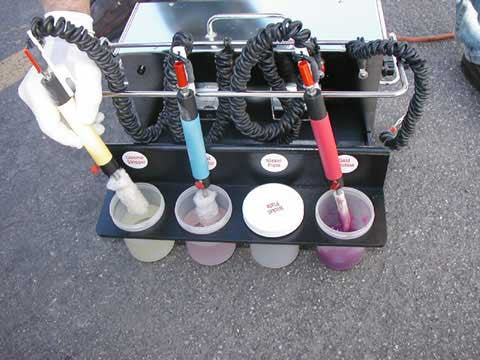
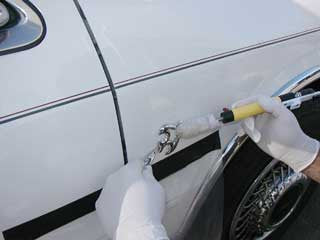 About 80% of automotive emblems, (such as the one shown here); are made of plastic. These emblems are manufactured using a platable grade of ABS plastic. The surface is then metalized, or made conductive, and then plated with copper, then nickel and finally with chrome. With this type of gold plating system, the chrome is electrochemically removed in the "chrome stripping" step using the yellow handle. This step has no effect on the underlying mirror bright nickel. The chrome removal process only affects the conductive surface of the emblem and will not harm most paint or factory surfaces. Virtually any item that has been chrome plated will have a bright nickel finish that readily receives the 24K gold plate. After the chrome has been completely removed the emblem and common lead is rinsed with tap water sprayed from a pistol grip sprayer. The chrome is in the solution and is rinsed down the drain apron into the waste water drain pan.
About 80% of automotive emblems, (such as the one shown here); are made of plastic. These emblems are manufactured using a platable grade of ABS plastic. The surface is then metalized, or made conductive, and then plated with copper, then nickel and finally with chrome. With this type of gold plating system, the chrome is electrochemically removed in the "chrome stripping" step using the yellow handle. This step has no effect on the underlying mirror bright nickel. The chrome removal process only affects the conductive surface of the emblem and will not harm most paint or factory surfaces. Virtually any item that has been chrome plated will have a bright nickel finish that readily receives the 24K gold plate. After the chrome has been completely removed the emblem and common lead is rinsed with tap water sprayed from a pistol grip sprayer. The chrome is in the solution and is rinsed down the drain apron into the waste water drain pan.
Nickel Activation
 In this step the exposed nickel surface is electrochemically activated. The emblem is given a negative charge relative to the activator solution carried by the "woolly" sleeve on the blue handle. The activator solution makes the nickel surface highly active and removes any oxides that could affect adhesion of the 24K gold plating. This is a quick step that only requires the technician to cover the entire surface at least once. Again, the factory paint is not affected by this step. Rinsing after activation is the same as rinsing after the chrome stripping step. This is a good time to inspect the nickel surface. Any remaining chrome or other defect in the nickel surface could show up in the gold plate.
In this step the exposed nickel surface is electrochemically activated. The emblem is given a negative charge relative to the activator solution carried by the "woolly" sleeve on the blue handle. The activator solution makes the nickel surface highly active and removes any oxides that could affect adhesion of the 24K gold plating. This is a quick step that only requires the technician to cover the entire surface at least once. Again, the factory paint is not affected by this step. Rinsing after activation is the same as rinsing after the chrome stripping step. This is a good time to inspect the nickel surface. Any remaining chrome or other defect in the nickel surface could show up in the gold plate.
Applying the 24K Gold
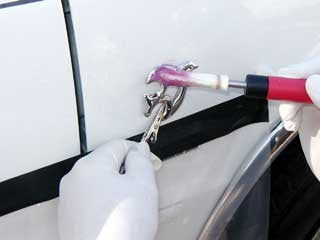 The red gold plating handle is connected to a special post-regulated power supply that delivers the precise amount of voltage required to electrodeposit the gold plating. The emblem is charged relative to the solution using the common lead. The output voltage of the gold handle is normally user controllable abut is rarely adjusted. For most applications the voltage is set to 5 volts. The gold should be applied using a power source that provides a very pure direct current with less than 5mv of ripple. The actual gold is contained in the Brush Gold Solution (purple liquid or gel). Brush plating gold solutions are usually proprietary formulas that are made with a complexed gold salt, (potassium aurocyanide), hardeners, brighteners and conductive salts that include a tiny amount of nickel and cobalt. The resulting solution will apply 7-10 micro-inches per square inch per minute of plating time. The gold is applied as a series of overlapping, concentric circles. The gold becomes opaque when the thickness reaches around 3 microinches (0.000003 inches). Automotive plating systems using this type of gold solution will apply 2 to 3 micro-inches per pass. An emblem is typically plated with 10-15 micro-inches.
The red gold plating handle is connected to a special post-regulated power supply that delivers the precise amount of voltage required to electrodeposit the gold plating. The emblem is charged relative to the solution using the common lead. The output voltage of the gold handle is normally user controllable abut is rarely adjusted. For most applications the voltage is set to 5 volts. The gold should be applied using a power source that provides a very pure direct current with less than 5mv of ripple. The actual gold is contained in the Brush Gold Solution (purple liquid or gel). Brush plating gold solutions are usually proprietary formulas that are made with a complexed gold salt, (potassium aurocyanide), hardeners, brighteners and conductive salts that include a tiny amount of nickel and cobalt. The resulting solution will apply 7-10 micro-inches per square inch per minute of plating time. The gold is applied as a series of overlapping, concentric circles. The gold becomes opaque when the thickness reaches around 3 microinches (0.000003 inches). Automotive plating systems using this type of gold solution will apply 2 to 3 micro-inches per pass. An emblem is typically plated with 10-15 micro-inches.
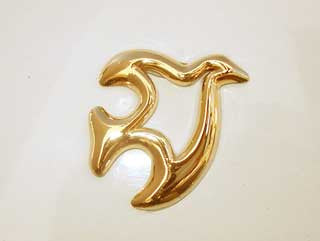 The finished emblem is rinsed off and inspected by the technician. If applied properly the 24K gold plating that has been applied to an emblem will meet strict technical standards MIL-G-45204-C. We have never had a problem offering a lifetime warranty against "peeling, flaking or corrosion of the gold plate we apply. Although 24K gold is soft, today’s brush plating solutions produce a gold plate that is almost three times as hard as a non-hardened gold plate.
The finished emblem is rinsed off and inspected by the technician. If applied properly the 24K gold plating that has been applied to an emblem will meet strict technical standards MIL-G-45204-C. We have never had a problem offering a lifetime warranty against "peeling, flaking or corrosion of the gold plate we apply. Although 24K gold is soft, today’s brush plating solutions produce a gold plate that is almost three times as hard as a non-hardened gold plate.
Typically you can expect to spend 6-10 minutes plating an average sized emblem. This includes set-up of the drain apron and drain pan. The cost of goods for this emblem is around $2.00. The going wholesale rate for plating an emblem varies from location to location but a good national average would range from $25 to $50 each. If you consider the lower side of $30 per emblem and a 5 emblem car takes you an hour, which leaves a lot of room for overhead.
The businesses that have most successful taken advantage of the demand for aftermarket gold plating are those that have been focused on customer service and providing a high quality product. Gold plating has a high perceived value and should be marketed as a valuable addition to a vehicle.
Author By-line; Terry Darger has worked in the automotive gold plating business since 1992 and currently is the general manager of Gold Plating Services. For questions email terry@goldplating.com.
